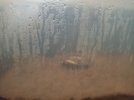tortoise Resort
Member
Hello everyone, I have searched most of the shops for bark and I did not find it , I got rid of the soil and sand as a substrate, i have idea for making a good hole with this soil 😀.
I will share with you as soon as I do, I was able to find oak shavings, am I using it as a temporary replacement ?or will it do more harm than good?
And I started using a heater instead of heat lamps, but I began to notice that the percentage of humidity was decreasing .
I will share with you as soon as I do, I was able to find oak shavings, am I using it as a temporary replacement ?or will it do more harm than good?
And I started using a heater instead of heat lamps, but I began to notice that the percentage of humidity was decreasing .
